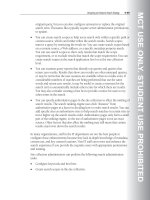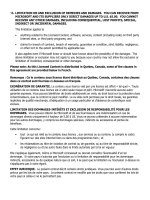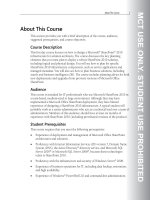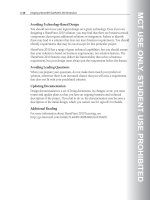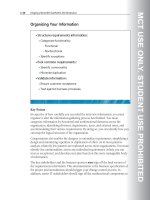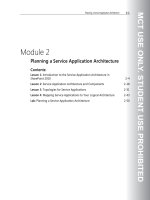Designing a Microsoft SharePoint 2010 Infrastructure Vol 1 part 41 ppt
Bạn đang xem bản rút gọn của tài liệu. Xem và tải ngay bản đầy đủ của tài liệu tại đây (727.79 KB, 10 trang )
MCT USE ONLY. STUDENT USE PROHIBITED
Planning Social Computing 8-19
What Are My Site Web Sites?
Key Points
Organizations provide users with their own personal sites by using My Site Web
sites, which enable users to share information about themselves and their work.
My Site Web sites provide a rich set of social networking and collaboration features
that encourage users to publicize their areas of expertise, the projects that they are
working on, and the relationships that they have with colleagues. Sharing this type
of information encourages collaboration, builds and promotes expertise, and
makes it easier for people to find relevant content.
Understandably, people have concerns about the privacy of the information that
they share. To help alleviate these concerns, you can plan for administrators to set
policies to protect privacy.
My Site Web sites include the following:
• A profile for each user where users can share their expertise, profile pictures,
and other information.
• A newsfeed for tracking activities such as social tags, status updates, and
comments by colleagues.
MCT USE ONLY. STUDENT USE PROHIBITED
8-20 Designing a Microsoft® SharePoint® 2010 Infrastructure
• A tag and note tool that helps you conveniently tag or post notes on sites
directly from a Web browser.
• A shared picture library, a shared document library, and a personal document
library.
• Web Parts such as an RSS viewer for viewing RSS feeds from blogs, or other
sources.
• An organization browser that uses Microsoft Silverlight® 3 to provide a
dynamic organizational browsing experience.
• A manageable list of colleagues.
Integrating User Profile Information
My Site Web sites rely on user profile synchronization, which enables you to
integrate profile information that is stored in a directory service. SharePoint 2010
can synchronize user profiles with Active Directory Domain Services or business
systems such as Siebel SharePoint 2010. My Site Web sites rely on user profile
synchronization, so you must also plan the deployment of the User Profile Service.
The User Profile Service stores information about users in a central location, and
My Site Web sites use this information to enable users to collaborate efficiently. To
provision My Site Web sites, enable social computing features such as social
tagging and newsfeeds, and create and distribute profiles across multiple sites and
farms, you must enable the User Profile Service.
As a result of user profile synchronization, consistent and timely information is
always available on a user’s My Site Web site. You can synchronize information
about users across the deployment to all site collections that use the same User
Profile Service application. Personalization features can also use this information to
increase the value of collaboration and relationships in an organization.
When you plan the synchronization of user profiles, you should include the
following tasks:
• Start with the default properties of user profiles in SharePoint 2010.
• Identify connections to directory services that will provide supplemental
information for properties of user profiles.
• Consider additional business data that enables you to connect users to line-of-
business (LOB) applications.
MCT USE ONLY. STUDENT USE PROHIBITED
Planning Social Computing 8-21
Question: What does the User Profile Synchronization Service provide for My Site
Web sites?
MCT USE ONLY. STUDENT USE PROHIBITED
8-22 Designing a Microsoft® SharePoint® 2010 Infrastructure
Planning My Site Web Sites
Key Points
When you plan My Site Web sites, you must plan which My Site Web site features
will be available to each user. You must answer the following questions to
determine access to features:
• Who can create personal sites?
• Who can create social tags and notes?
• Who can add colleagues?
To ensure simplicity of management, you should plan to assign permissions to
security groups only where necessary. The following table provides guidance for
configuring permissions.
MCT USE ONLY. STUDENT USE PROHIBITED
Planning Social Computing 8-23
Permission Guidance
Create
Personal
Site
By default, all authenticated users can create a My Site Web site. Ensure that
you want the default setting to apply to the organization. Alternatively, you can
use one or more security groups to grant the Create Personal Site permission to
a subset of users in an organization.
Use Social
Features
By default, all authenticated users can add ratings and social tags to documents,
to other Office SharePoint Server items, and to other items, such as external
Web pages and blog posts. Users can also leave impromptu notes on profile
pages of a My Site Web site or any Office SharePoint Server page. Alternatively,
you can use one or more security groups to grant the Use Social Features
permission to a subset of users in an organization.
Use
Personal
Features
By default, all authenticated users can edit their profiles, add or edit colleagues,
and add or edit memberships. Alternatively, you can use one or more security
groups to grant the Use Personal Features permission to a subset of users in an
organization.
The My Site Web sites that are created, the social tags and notes, the colleague lists,
and other content that is used in a My Site Web site must be stored. In
organizations that have large numbers of active My Site Web sites, storage
management can become a major task for the SharePoint 2010 administrator. You
can mitigate this potential problem by planning the storage and maintenance of
My Site Web sites before you deploy them. You must plan how you will store the
My Site Web sites and how you will manage, monitor, and maintain that storage.
How Are My Site Web Sites Hosted?
The My Site Host is a site collection that you use for hosting the profile and
newsfeed parts of My Site Web sites. Content for My Site Web sites is hosted in its
own site collection. My Site Host collections are not automatically created; an
administrator of the User Profile Service application must create a My Site Host site
collection before provisioning My Site Web sites.
For optimal performance, you should create the My Site Host in a dedicated Web
application. In geographically distributed SharePoint infrastructures, you can
create multiple Web applications to host My Site Web sites and then use trusted
My Site Host locations to target particular Web applications for specific groups of
users.
MCT USE ONLY. STUDENT USE PROHIBITED
8-24 Designing a Microsoft® SharePoint® 2010 Infrastructure
Trusted My Site Host Locations
In organizations where multiple server farms are deployed or where multiple User
Profile Service applications are configured, it is possible for users to create multiple
My Site Web sites, although this may not be desirable.
If your organization includes multiple farms or multiple User Profile Service
applications that host My Site Web sites, you should consider whether to prevent
users from creating multiple My Site Web sites.
Using the Trusted My Site Host Locations feature can prevent users from creating
multiple My Site Web sites. This feature enables you to specify trusted My Site
locations, which enable users to be redirected to the My Site Web site that is
intended for their user accounts, regardless of where they are browsing when they
attempt to create a My Site Web site. This feature ensures that each user creates
only one My Site Web site in the organization. You can manage Trusted My Site
Host Locations by specifying target audiences for each location.
Geographically Distributed Deployments
In organizations that are widely dispersed geographically, planning for My Site
Web sites must include considering the location of the users in the organization.
Best practice is to target trusted My Site locations for groups of users based on
their physical location, unless there is an overriding business requirement to do
otherwise.
Question: How can you use trusted My Site locations to help manage My Site
Hosts?
MCT USE ONLY. STUDENT USE PROHIBITED
Planning Social Computing 8-25
What Is Social Tagging?
Key Points
Social tags are user-generated words or phrases that describe pieces of information
according to a set of attributes or criteria. Tags make it easy to find and share
information about a specific subject or task. Tags are not part of a formal
taxonomy, such as the enterprise keywords in the term store that is associated with
a Managed Metadata Service application; users create social tags based on their
experience with a specific piece of information.
Social Tagging Features
SharePoint 2010 contains the following social tagging features:
• Social tags. These enable users to save items of interest, organize all
information for a project, and connect to others who share their interests.
Although tags themselves are public, you can choose to prevent others from
seeing that you have tagged a specific item by marking that tag as private.
• The note board. This enables users to add comments about Web pages,
documents, and library items to be tracked in a central location. Notes are
always public.
MCT USE ONLY. STUDENT USE PROHIBITED
8-26 Designing a Microsoft® SharePoint® 2010 Infrastructure
• Ratings. These are social tags that enable users to assess the value of content
against a scale, for example, one through five stars.
• Bookmarklets. These enable users to add tags and notes to pages that are
outside a SharePoint environment. For example, if users add tags to a page on
an Internet Web site, these tags and notes can appear on the Tags and Notes
tab of their My Site Web site.
The Use Social Features permission of the User Profile Service controls the ability
to use social tags, the note board, and ratings. By default, all authenticated users
can add social tags to documents and other SharePoint items, and anyone with the
Manage Social Data permission can delete a tag.
Tag clouds provide a view of the tags that a group of users have applied to a single
piece of information. Frequently used tags are displayed in large, bold text; tags
that are used less often appear in smaller text. By default, each user’s My Site Web
site includes a tag cloud Web Part.
Benefits of Social Tagging
Organizations can benefit from the consistent use of social tagging. However, the
information that social tagging provides is only useful if it is complete and
consistently applied. When you design a plan for social computing in an
enterprise, you must plan how to foster a culture of using the social computing
features. The information that users receive when they click a tag or perform a
search must be accurate and up to date. This is important; if users cannot trust the
data, these features will cease to be valuable and will fall out of use.
Fully utilized social tagging provides the following benefits:
• It improves collaboration and improves the discoverability of business
information.
• It enables users to identify themselves and find experts. Note board comments
can identify a group of users who are interested in a specific topic. Suggestions
for a user's My Colleagues list can be derived from these social connections.
• It increases the visibility of high-quality content and identifies the latest version
of content. For example, a My Site Web site feed can notify a user when a Web
page is tagged with a tag that the user has included in his or her user profile.
MCT USE ONLY. STUDENT USE PROHIBITED
Planning Social Computing 8-27
Performance and Capacity
Your plan for social computing must include adequate storage for social tagging.
Poor performance and capacity issues can discourage users from participating in
social tagging activities.
Social tags consist of a user identity, an item URL, and the tag itself. Social tags are
stored in the social tagging database that is part of the User Profile Service.
The terms that are used in tags are stored in a term store, which the Managed
Metadata Service manages. The term store does not identify the person who
created the tag or the Web page to which the tag was applied.
Although individual tags, ratings, bookmarklets, and comments require very little
storage space, cumulatively they affect the size of the profile database, the term
store, and the social tag database. Given the rapid increase in adoption of social
tagging, your implementation must be able to scale out to accommodate large
numbers of new users.
Question: Where are social tags stored?
MCT USE ONLY. STUDENT USE PROHIBITED
8-28 Designing a Microsoft® SharePoint® 2010 Infrastructure
Planning Social Tagging
Key Points
Planning social tagging requires consideration of the user’s privacy. You must
ensure that appropriate safeguards are in place, to prevent the violation of a user's
privacy or the exposure of content that should be kept secure. When you plan for
social computing, you should consider setting user profile policies to help protect
sensitive information. User profile policies help to protect privacy but also provide
users with some discretion in their use of social features.
In addition, administrators can help to safeguard sensitive content by excluding
sites from social tagging. For example, an administrator can add a site URL to a list
of excluded sites to prevent the site and any sub-sites from being tagged.
Your plan for social computing must include user training and education about the
security and privacy implications of social tagging features. For example, users
must understand that when a site or document is tagged, the title and URL of that
site or document is broadcast to anyone who lists that user as a colleague on their
My Site Web site and anyone who has that tag listed as an interest in their user
profile.
